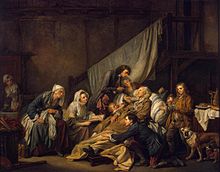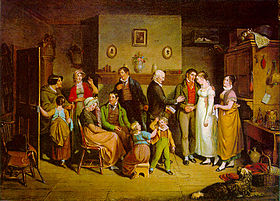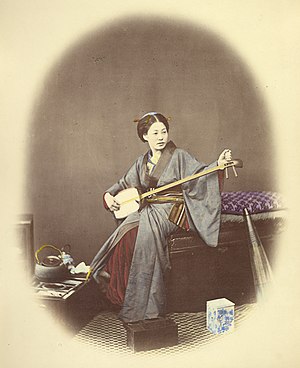Genre art
This article includes a list of general references, but it lacks sufficient corresponding inline citations. (September 2013) |

Genre art is the pictorial representation in any of various media of scenes or events from everyday life,[1] such as markets, domestic settings, interiors, parties, inn scenes, work, and street scenes. Such representations (also called genre works, genre scenes, or genre views) may be realistic, imagined, or romanticized by the artist. Some variations of the term genre art specify the medium or type of visual work, as in genre painting, genre prints, genre photographs, and so on.
The following concentrates on painting, but genre motifs were also extremely popular in many forms of the decorative arts, especially from the Rococo of the early 18th century onwards. Single figures or small groups decorated a huge variety of objects such as porcelain, furniture, wallpaper, and textiles.
Genre painting
Genre painting, also called genre scene or petit genre, depicts aspects of
To 1800

The

In
In England, William Hogarth (1697–1764) conveyed comedy, social criticism and moral lessons through canvases that told stories of ordinary people full of narrative detail (aided by long sub-titles), often in serial form, as in his A Rake's Progress, first painted in 1732–33, then engraved and published in print form in 1735.
Spain had a tradition predating
19th century



With the decline of religious and historical painting in the 19th century, artists increasingly found their subject matter in the life around them.
William Powell Frith (1819–1909) was perhaps the most famous English genre painter of the Victorian era, painting large and extremely crowded scenes; the expansion in size and ambition in 19th-century genre painting was a common trend. Other 19th-century English genre painters include Augustus Leopold Egg, Frederick Daniel Hardy,[4] George Elgar Hicks, William Holman Hunt and John Everett Millais. Scotland produced two influential genre painters, David Allan (1744–96) and Sir David Wilkie (1785–1841). Wilkie's The Cottar's Saturday Night (1837) inspired a major work by the French painter Gustave Courbet, After Dinner at Ornans (1849). Famous Russian realist painters like Pavel Fedotov, Vasily Perov, and Ilya Repin also produced genre paintings.
In Germany, Carl Spitzweg (1808–85) specialized in gently humorous genre scenes, and in Italy Gerolamo Induno (1825–90) painted scenes of military life. Subsequently, the Impressionists, as well as such 20th-century artists as Pierre Bonnard, Itshak Holtz, Edward Hopper, and David Park painted scenes of daily life. But in the context of modern art the term "genre painting" has come to be associated mainly with painting of an especially anecdotal or sentimental nature, painted in a traditionally realistic technique.
The first true genre painter in the United States was the German immigrant John Lewis Krimmel, who learning from Wilkie and Hogarth, produced gently humorous scenes of life in Philadelphia from 1812 to 1821. Other notable 19th-century genre painters from the United States include George Caleb Bingham, William Sidney Mount, and Eastman Johnson. Harry Roseland[5] focused on scenes of poor African Americans in the post-American Civil War South,[6] and John Rogers (1829–1904) was a sculptor whose small genre works, mass-produced in cast plaster, were immensely popular in America. The works of American painter Ernie Barnes (1938–2009) and those of illustrator Norman Rockwell (1894–1978) could exemplify a more modern type of genre painting.
Genre in other traditions
Japanese ukiyo-e prints are rich in depictions of people at leisure and at work, as are Korean paintings, particularly those created in the 18th century.
Gallery of Flemish genre paintings
-
Jan Sanders van Hemessen, Brothel scene, c. 1545–1550.
-
David Teniers the Younger, Tavern scene, 1640.
-
Joos van Craesbeeck, Soldiers and Women, 1640s
Gallery of Dutch 17th-century genre paintings
-
Hendrick Avercamp painted almost exclusively winter scenes of crowds.
-
Utrecht Caravaggists.
-
Judith Leyster, A Boy and a Girl with a Cat and an Eel, c. 1635
Genre photography

While genre painting began, in the 17th century, with representations by Europeans of European life, the invention and early development of photography coincided with the most expansive and aggressive era of European imperialism, in the mid-to-late 19th century, and so genre photographs, typically made in the proximity of military, scientific and commercial expeditions, often also depict the people of other cultures that Europeans encountered throughout the world.
Although the distinctions are not clear, genre works should be distinguished from ethnographic studies, which are pictorial representations resulting from direct observation and descriptive study of the culture and way of life of particular societies, and which constitute one class of products of such disciplines as anthropology and the behavioural sciences.
The development of photographic technology to make cameras portable and exposures instantaneous enabled photographers to venture beyond the studio to follow other art forms in the depiction of everyday life. This category has come to be known as street photography.[7][8][9]
See also

Notes
- ^ Art & Architecture Thesaurus, s.v. "genre" Archived 2018-07-31 at the Wayback Machine. Accessed 2 November 2006.
- ^ Book XXXV.112 of Natural History
- ^ "E. de Jongh, 'Erotica in vogelperspectief. De dubbelzinnigheid van een reeks zeventiende-eeuwse genrevoorstellingen'". DBNL. Retrieved 16 March 2018.
- ISBN 978-185149-826-0.
- ^ Canu, John F. "ART / 4 / 2DAY". www.safran-arts.com. Retrieved 16 March 2018.
- PMID 1566698.
- ISBN 9780821227268.
- ^ The Sidewalk Never Ends: Street Photography Since the 1970s by Colin Westerbeck, Chicago: Art Institute of Chicago, 2001.
- ISBN 978-0-500-54393-1 "Thames & Hudson Publishers | Essential illustrated art books | Street Photography Now". Archived from the originalon 2010-10-03. Retrieved 2010-10-09..
References
- Ayers, William, ed., Picturing History: American Painting 1770-1903, ISBN 0-8478-1745-8
- Banta, Melissa. 'Life of a Photograph : Nineteenth-Century Photographs of Japan from the Peabody Museum and Wellesley College Museum'. In A Timely Encounter: Nineteenth-Century Photographs of Japan (ex. cat.; Cambridge, Massachusetts: Peabody Museum Press, 1988), 12.
- Banta, Melissa, and Susan Taylor, eds. A Timely Encounter: Nineteenth-Century Photographs of Japan (ex. cat.; Cambridge, Massachusetts: Peabody Museum Press, 1988).






